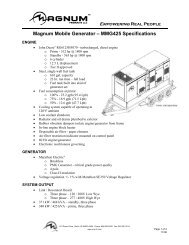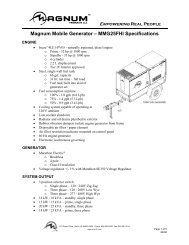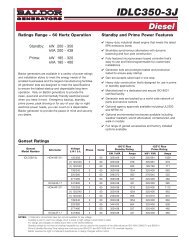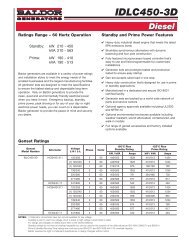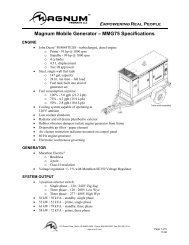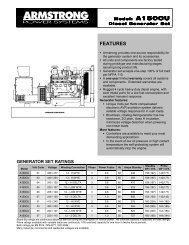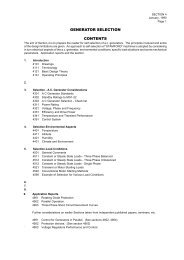GENERATOR SELECTION CONTENTS - Diesel Generator
GENERATOR SELECTION CONTENTS - Diesel Generator
GENERATOR SELECTION CONTENTS - Diesel Generator
You also want an ePaper? Increase the reach of your titles
YUMPU automatically turns print PDFs into web optimized ePapers that Google loves.
GENERAL COMMENTS ON LOAD CONDITIONS<br />
SECTION 4501<br />
January, 1990<br />
Page 1<br />
Section 4.5 is concerned with the effect of load upon the a.c. generator and on correct generator sizing. The majority<br />
of a.c. generator applications are in supplying electricity to standard loads such as lighting, heating, ventilation, and<br />
an infinite variety of motor drives. These loads, and loads of a more complex nature, are considered in the sections<br />
following these general comments. However any doubts about sizing should automatically mean reference to the<br />
factory.<br />
Some specialised loads such as computers and transmitting stations may demand very specific performance<br />
parameters. In these cases advice from the factory should be sought. Were are specification exists for any particular<br />
load or installation, it is always advisable to forward a complete copy of the factory for examination. As a result of such<br />
an assessment it is sometimes possible to incorporate design changes to provide a more economic machine which<br />
still meets the specification.<br />
In arriving at a total load figure it is always wise to select the standard rating larger than that estimated. This despite<br />
the fact that all the loads may not be operating at the same time and hence a smaller machine could have been<br />
selected. Future operating conditions and future growth are very difficult to estimate. An allowance of 15% to 20%<br />
excess capacity designed into a set now is a small price to pay compared with the cost of a completely new larger unit<br />
that may be required to drive additional loads in a few year’s time. The exceptions are sets solely for emergency<br />
service, when only the essential loads need be included.<br />
There are two basic conditions to check when sizing machines. The steady state condition, which is mainly concerned<br />
with normal operation of the machine within temperature rise limits; and the transient condition, which examines<br />
voltage deviations when suddenly applying high current loads (e.g. during motor starting). It is essential that both<br />
these conditions are checked as a rating sufficient for the stead state condition is often not large enough to meet<br />
motor starting or voltage dip requirements. Calculation methods and examples for both conditions follow. The base<br />
unit for the two conditions is also different. The steady state calculation normally uses kW output from the a.c.<br />
generator as the base unit, which can also be used to ensure that the correct power size of prime mover is selected,<br />
without overload. Transient calculations are conducted to the base of kVA. Note that without exception.<br />
KW = kVA x power factor<br />
It is the nature of the applied load that dictates the system power factor. Loads that operate at or very close to unity<br />
(1.0) power factory include most forms of lighting, all hearing elements, rectifier and thyristor type loads; in fact any<br />
load which does not include an induction coil (motor). Generally, all domestic loads can be considered as unity power<br />
factor since any motors (washing machine, refrigerator, etc.) represent only a small part of the load, being normally<br />
fractional horsepower motors. For all remaining load types, some knowledge of operating power factor is required,<br />
which for motors depends a great deal on their size and power rating.<br />
Newage Stamford a.c. generators perform satisfactorily at any power factor in the range of 0.8 p.f. lag to unity p.f.<br />
Operation at leading power factors usually demands a derate and reference to the factory must be made if leading<br />
power factor loads are under consideration. Lagging power factors below 0.8 p.f. also require the machine to be derated.<br />
Under certain circumstances a high level of fluorescent lighting load should be considered with caution. Some are<br />
manufactured uncompensated with operating power factors as low as 0.5 p.f. lag, although the majority are capacitor<br />
corrected to around 0.9 p.f. lag. The two most disturbing effects of fluorescent are the waveform distortion created by<br />
high third harmonics in the current waveform and the switching transient created by the ‘starter’ equipment. These<br />
can adversely affect other connected leads and where doubt arises advice should be sought from the factory.<br />
In considering the various load conditions following, reference is made to typical performance figures. It must be<br />
noted that any attempt to be specific can be done with the true performance figures for the load in question. Full and<br />
detailed technical information of current consumed under both starting and running conditions must be obtained from<br />
the manufacturer of the load.



